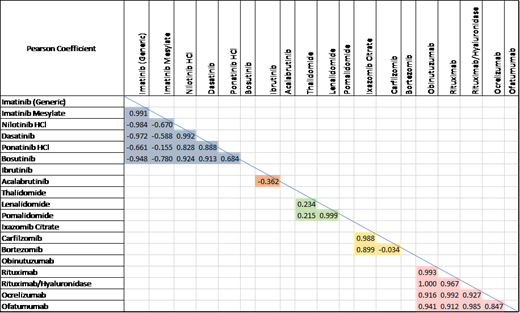Abstract
Background:
Despite the promise of targeted agents in hematology, the high price of cancer therapies is a rapidly evolving problem. Until now, the increase in price of targeted anti-cancer treatments used in common hematological malignancies has not been evaluated. Here, we report patterns in price changes from 2015-2019 for multiple in-class anticancer medications for common hematologic malignancies.
Methods:
We utilized the publicly available Medicare Part D provider utilization and payment database from 2015 to 2019. We extracted drug prices (using generic names) for commonly used targeted anticancer agents for acute myeloid leukemia, chronic myeloid leukemia, chronic lymphocytic leukemia, B-cell lymphomas, and multiple myeloma. The primary outcome was the correlation of average change in Medicare spending per dosage unit among the multiple brand-name medications within each class available. We additionally calculated compound annual growth rates (CAGRs) [i.e. mean annual growth rates over a specified period of time] for medication costs within each class, and compared it with the consumer price index (CPI) (a measure of the average change over time in the prices of consumer items) and inflation rate. Agents without in-class competitor were excluded. CPI and inflation rates came from U.S. Bureau of Labor Statistics.
Results:
The study included 6 BCR-ABL inhibitors (1 generic), 2 BTK inhibitors, 2 IDH inhibitors, 2 FLT3 inhibitors, 3 IMIDs, 3 PI, 2 PI3K inhibitors, and 5 anti-CD20 monoclonal antibodies.
The median (range) Pearson correlation coefficient values for drugs within each class were -0.155 (-0.984-0.992) for BCR-ABLi, -0.362 for BTKi, 0.234 (0.215-0.999) for IMIDs, 0.899 (-0.034-0.988) for PIs, and 0.954 (0.847-0.999) for anti-CD20 antibodies. The median correlation coefficient for BCR-ABLi was 0.751 if generic imatinib was excluded. The correlation coefficient between 2 nd and 3 rd generation IMIDs was 0.999. Non-generic BCR-ABLi and anti-CD20 antibodies showed strong linear association in price increase between two drugs within the same class. Due to drug novelty, coefficient could not be calculated for therapies with 2 or fewer data points (midostaurin, gilteritinib, enasidenib, ivosidenib, idelalisib, duvelisib). There was no significant correlation between expenditure for BTKi, PIs, and IMIDs.
The median CAGRs in costs over this 5-year period were: were 6.29% for BCR-ABLi, 18.36% for BTKi, 2.69% for IDHi, 4.23% for FLT3i, 10.63% for IMIDs, 5.11% for PIs, 5.79% for PI3Ki, and 5.85% for anti-CD20s. The median CAGR in costs for modern precision-driven cancer therapeutic classes outpaced CPI (2.26%/year), and the average inflation rate (1.90%/year).
Conclusions:
Increase in cost within the same class should be weighed against incremental clinical benefit for the patients. For non-generic BCR-ABLi and anti-CD20 antibodies, despite there being several agents, the rise in drug expenditures correlated closely, calling into question the true value of within-class competition. There is an urgent need for drug pricing reform given the average expenditure of Medicare part D, and ultimately out-of-pocket costs for our patients with cancer continues to trend upwards. Increased advocacy efforts are needed to ensure precision therapeutics remains an attainable and sustainable goal.
No relevant conflicts of interest to declare.


This feature is available to Subscribers Only
Sign In or Create an Account Close Modal